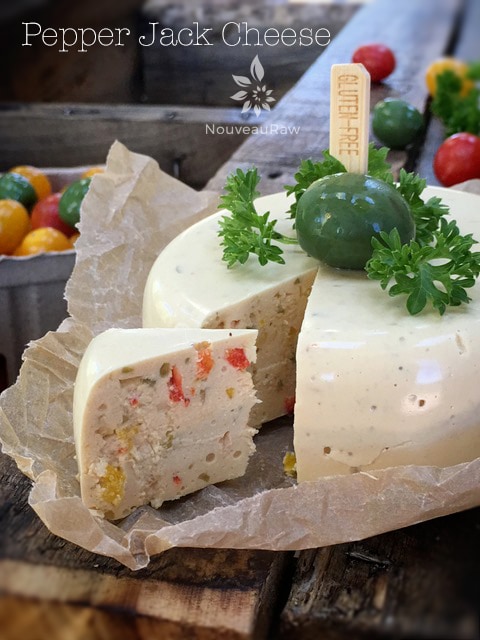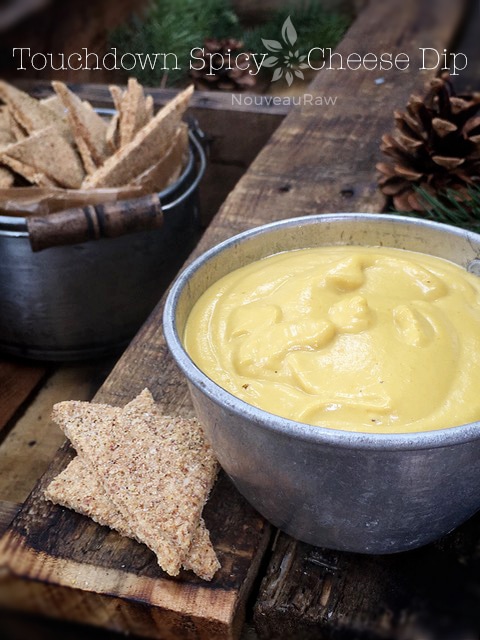– Cheese Making 101 – Ingredient Glossary (raw and/or vegan)

 Add to favorites
Add to favorites
 There are many wonderful ingredients that can be used when creating vegan cheeses. Some of these additives are not raw, but that doesn’t mean that they are bad for you. Below, I have started a list of ingredients that you might find in my recipes.
There are many wonderful ingredients that can be used when creating vegan cheeses. Some of these additives are not raw, but that doesn’t mean that they are bad for you. Below, I have started a list of ingredients that you might find in my recipes.
Perhaps after reading through them, you will find some inspiration for playing around in the kitchen, making your own creations!
Nuts & Seeds –
- Most vegan cheeses use some kind of nut or seed as a base; cashews, macadamia nuts, almonds, and sunflower seeds are most commonly used.
- If using almonds, I recommend removing the skins after the soaking process. Learn how (here).
- Soaking the nuts or seeds is a major step. Not only does the soaking process soften them, but it also reduces phytic acid, an antinutrient that prevents the body from absorbing some vitamins and minerals.
Agar –
- Agar-agar is a sea vegetable that is insoluble in cold but soluble in boiling water. When boiled, agar becomes liquid and when cooled it forms a clear, gel-like substance. It’s melting temperature is 85-95 °C (185-203 °F), and gelling temperature (when cooled down) is 30-40 °C (86-104 °F) (source). Therefore, it isn’t a raw ingredient.
- It has beautiful gelling properties and create a firm (not hard) texture in cheese so that it can be sliced, grated and even melted if so desired.
- Agar agar has no taste, no odor and no color, which makes it pretty convenient to use.
- Available in powder and flake form. In my recipes, I only use the powder form and find it very predictable. If you use flakes, you will need to use triple the amount than you would of powder in a recipe.
- A little bit goes a long way. There is a little science and a little art to this using this product. If you use too little, the cheese won’t hold a shape. If you use too much, it can be used as a bouncing ball.
- When working with agar be aware that it will not set in wine vinegar or in distilled water. It will also not set in foods containing a large amount of oxalic acid, such as chocolate or spinach.
- Agar agar is a good source of calcium and iron and is very high in fiber. It contains no sugar, no fat and no carbohydrates.
- It also absorbs glucose in the stomach, passes through digestive system quickly and inhibits the body from retaining and storing excess fat. Its water absorbing properties also aids in waste elimination. (source)
Irish Moss
- Irish Moss is unprocessed, raw seaweed, which can be used as a gelling agent without cooking. It’s an amazing thickener and emulsifier.
- As with all foods, the quality and source are necessary. Not all brands “play” the same.
- It won’t create a sliceable cheese, but it will add a lot of body and a smooth texture.
- In my recipes, I use Irish Moss in its whole form, never in flake or powder form.
- Irish moss has a soothing effect on the mucous membranes throughout the body which as well as the digestive tract and also has a mild laxative effect.
- It contains antioxidants to help fight free radicals, strengthens connective tissues and joints, and is great or the skin.
- Click (here) to learn more.
 Rejuvelac
Rejuvelac
- Rejuvelac is a fermented grain beverage that can also be used as a “starter” in culturing nut and/or seed cheeses.
- It’s high in enzymes and contains important Lactobacillus Bifidus and lactic acid.
- It is much more economical than opening probiotic capsules for the powder, but it does take anywhere from 2-5 days to make.
- You can use just about any grain to make rejuvelac. Quinoa is the fastest sprouting grain so keep that in mind if you are pressed for time.
- It will last 2-3 weeks in the fridge. Rejuvelac can be used in many other recipes such as yogurt, a culture starter for culturing veggies, and it is great to consume as a drink.
- For ratio purposes, use anywhere from 1/4 – 1/2 cup of rejuvelac to 2 cups of nuts or seeds. Some nuts absorb quite a bit of water during the soaking process. Therefore they won’t need as much liquid when blending them into a smooth texture. So start with 1/4 cup and work yourself up as/if needed.
Probiotics –
- Use 1/2 teaspoon of probiotic powder and 1/4 cup of water in place of 1/4 cup of rejuvelac.
- When using probiotics, you will need 24-72 hours of culturing time. This process is done at room temperature and once placed in the fridge the culturing process will slow to a crawl.
- Probiotics boost the immune system, help to prevent and treat urinary tract infections, and can improve digestive function. It is also said to heal inflammatory bowel conditions like IBS. The list goes on. Please Google it to learn more!
Lemon Juice
- Lemon juice adds a tang to cheese recipes and is good to use in a pinch when you don’t have time to culture the cheese.
- Use freshly squeezed for the best flavor.
- Lemons contain vitamin C, vitamin B6, vitamin A,vitamin E, folate, niacin thiamin, riboflavin, pantothenic acid, copper, calcium, iron, magnesium, potassium,zinc, phosphorus and protein.
Miso –
- Miso is a paste made from fermented soybeans, chickpeas, or other legumes or grains.
- Miso can be used in cultured and non-cultured cheeses. It’s a good choice when you don’t have the time to go through a full culturing process.
- It adds saltiness and an aged-cheese-like flavor. When using miso, it’s possible to reduce or even omit salt from the recipe. Miso comes in multiple colors which indicate the range of flavor. Light tan color indicates a more mellow flavor. The darker the miso color, the stronger it is. The color offers a various degree of mellowness, saltiness, and even sweetness. Be aware of this when substituting miso’s.
 Nutritional Yeast –
Nutritional Yeast –
- This is very different from bakers yeast, don’t confuse the two. It is an inactive yeast which means that it has no fermenting power like live yeast does when making bread.
- Nutritional yeast lends a cheesy flavor to recipes.
- My favorite brand is Red Star Nutritional Yeast, not only in the flavor department but it is an excellent source of B12. I have tested many brands and prefer the flavor and quality of this brand by far.
- It comes in powder or flake form. I use the flake form in all my recipes (unless specified).
- Do not substitute any other type of yeast in place nutritional yeast.
Salt –
- Salting the surface of the cheese will help suppress the growth of mold and creepy bacterias.
- Salting the exterior will also help develop flavor in the cheese.
- When using salt to coat the outside of the cheese block while air-drying it (aging it) please make sure that is non-iodized, so it doesn’t damage the lactic acid cultures. This can lead to mold.
- Rub the cheese form with salt before aging and after a few days of drying.
Raw Coconut Butter –
- I will often add this to soft spreadable cheeses with a ratio of 2 cups of nuts/seeds to 2 Tbsp of coconut butter. Any more and it will be too firm.
- It creates a spreadable texture, and when used in moderation, it won’t affect the overall flavor of the recipe.
- Coconut butter is also referred to as coconut manna.
- Coconut butter differs considerably from coconut oil. Click (here) to learn the difference between the two.
I have quite a “spread” of nut and seed based cheese recipes on my site. Be sure to visit them (here).

© AmieSue.com
Tags: Dairy Free, Gluten Free, Refined Sugar Free, Soy Free, Vegan



 Add to favorites
Add to favorites
 There are many wonderful ingredients that can be used when creating vegan cheeses. Some of these additives are not raw, but that doesn’t mean that they are bad for you. Below, I have started a list of ingredients that you might find in my recipes.
There are many wonderful ingredients that can be used when creating vegan cheeses. Some of these additives are not raw, but that doesn’t mean that they are bad for you. Below, I have started a list of ingredients that you might find in my recipes. Rejuvelac
Rejuvelac Nutritional Yeast –
Nutritional Yeast –
You are great! I was just expecting also some techniques explained as the name mas saying Master Class. I guess, I will find letter.
These are sections that I am building up Chiaramente :)